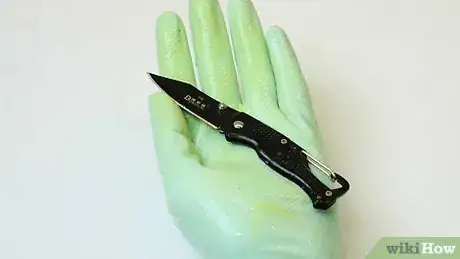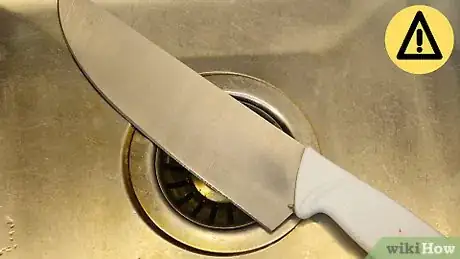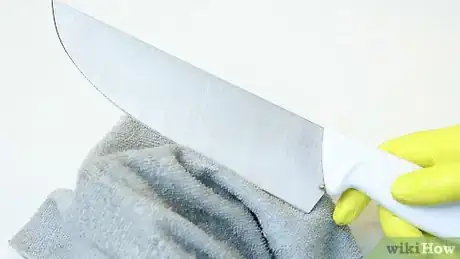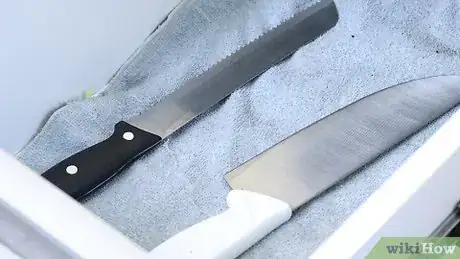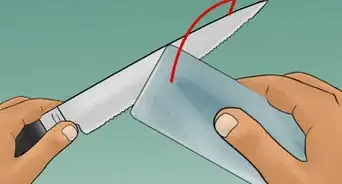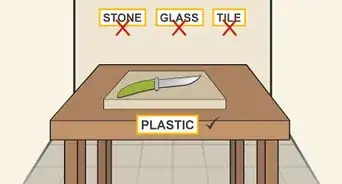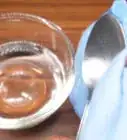This article was co-authored by Jillian Fae Downing. Jillian Fae Downing is a Private Event Chef, Chef Educator, and the Owner of Jillian Fae Chef Services based out of Temecula, California. With 12 years of experience, she specializes in menu planning and menu research and development. Jillian Fae holds an Associate of Science in Culinary Arts from Orange Coast College and a BA in Mass Communication and Media Studies from Arizona State University. She is also a member of the American Culinary Federation and the American Personal and Private Chef Association.
This article has been viewed 352,142 times.
Knives of all types need to be regularly cleaned to keep them sharp, rust-free, and free of bacteria. They require special handling and care, depending on the type of knife and their various uses.
Steps
Cleaning a Kitchen Knife
-
1Wipe the knife clean right after each use. Kitchen knives will be harder to clean if you allow debris to get stuck on. After using a knife, quickly run the knife under water. Allow any food or debris to brush off and drain down the sink. Make sure to clean the whole knife, not just the blade. If there's anything stuck on the knife, quickly wipe it down with a sponge or dish towel. Set the knife aside until you're ready to do dishes.[1]
-
2Clean with the blade pointed away from you. Once you're ready to clean the knife, use a mild dish soap. Be careful to clean the knife with the blade pointing away from you to avoid injury.
- Lather a sponge in warm, soapy water. With the blade pointing away from you, gently clean the knife until you remove all food and stains.[2]
- Be careful not to scrub too fast. If you scrub vigorously or quickly, the knife could slip and you could end up getting cut. Some people feel more comfortable lying the knife on a flat counter top and scrubbing the sides one at a time. This can make injury less likely.[3]
Advertisement -
3Soak the knife for a minute or two if food is stuck on. Sometimes, food will end up stuck on a kitchen knife despite your best efforts. In this case, soak the blade in shallow water for a minute or two. After this, you should be able to scrub away the food. Do not soak a knife longer than one or two minutes as this can cause rust.[4]
-
4Dry the knife. Always dry your knife with a dry, clean towel immediately after cleaning. Knives should not air dry as this can cause rust. Dry the knife with the blade facing away from you, just as you did when washing the knife.[5]
Cleaning a Pocket Knife
-
1Wear rubber gloves. When cleaning a pocket knife, you should always wear rubber gloves. They protect your hands from getting cut by the blade. You'll also be using certain oils or cleaners that can cause skin irritation. You can buy rubber gloves at most supermarkets.[6]
-
2Gather necessary materials. You'll need certain supplies to clean a pocket knife. Get the materials ready before you begin the cleaning process.
- For the initial washing, use mild dish detergent. The soap you use for day-to-day dish washing is probably fine. Just do not use dish soap intended to be used in a dishwasher as it's too harsh for knives and can cause rust and other damage.[7]
- You'll need some kind of household lubricant to remove rust. WD-40 tends to work well on pocket knives. You'll also need household oil to lubricate the knife after washing. You should be able to find household lubricant and oil at a hardware store.[8]
- You will need a soft sponge or a toothbrush for the initial washing. To deal with rust, a nylon pad is necessary. You'll also need a soft, clean cloth to dry the knife when you finish cleaning.[9]
-
3Open the knife completely. When you're ready to clean a pocket knife, open the knife completely. Some pocket knives, like Swiss Army knives, might have multiple utensils attached. Make sure the knife is completely open so all portions are cleaned.
-
4Scrub the knife with dish detergent. First, spot clean the knife with regular dish detergent and a sponge. Lather the sponge in warm, soapy water and clean off the blades of the knife. If you notice anything stuck on the knife, squirt dish detergent directly on the spot, let it sit for a few minutes, and then resume scrubbing.[10]
-
5Remove rust. If you have rust that needs removing, use the household lubricant. Spray all rusty areas and let the lubricant sit on for one minute. Then, take your nylon pad and scrub the blade until the rust disappears. You may need to add additional household lubricant on stubborn spots. Once you are done, rinse the knife off with clean running water.[11]
-
6Dry the knife and apply lubricant. Dry your knife off with a clean cloth. Then, add a few drops of the household lubricant to the knife. Rub in with another dry cloth until the knife is shiny and clean in appearance.[12]
Knowing Basic Knife Maintenance
-
1Do not leave knives in the kitchen sink. You should never leave a knife in the kitchen sink. It's a safety issue as you could get cut reaching into the dish water. Knives are also susceptible to damage and rust if immersed in water for too long. Place dirty knives beside the kitchen sink.[13]
-
2Dry knives immediately after washing. As stated, leaving knives wet can increase their likelihood of rusting. Always dry your knives immediately after cleaning them.[14]
-
3Avoid the dishwasher, especially on expensive knives. Knives do not do well in the dishwasher. The blade can get dinged and damaged during the washing cycle. Dishwasher detergent is also highly acidic and can cause premature rusting.[15]
-
4Store quality knives in their own space separate from the utensil drawer. Quality kitchen knives should not be stored in the utensil drawer. They can bump against other silverware, causing scratches and other damage. Invest in a kitchen board to store your knives or keep them in a separate drawer. If you do store your knives in the utensil drawer, cover them in leather sheaths.[16]
Community Q&A
-
QuestionIf I don't care if my knife is shiny, but I still want it to be clean, do I need the lubricant?
 Community AnswerIf you are using a carbon steel knife, yes. The oil helps keep the knife from rusting.
Community AnswerIf you are using a carbon steel knife, yes. The oil helps keep the knife from rusting. -
QuestionHow do I remove fruit juice from my knife?
 Community AnswerHot water and soap. Then towel dry the knife and allow it to fully air dry, if possible.
Community AnswerHot water and soap. Then towel dry the knife and allow it to fully air dry, if possible. -
QuestionHow do I remove blood from a knife blade after I've cut myself?
 Community AnswerEither use milk, or, if you have it available, make a very thick paste of baking soda and water. Dip a dish brush in vinegar, and use that to scrub the knife. Then rinse that off, and wash with hot water and soap as usual.
Community AnswerEither use milk, or, if you have it available, make a very thick paste of baking soda and water. Dip a dish brush in vinegar, and use that to scrub the knife. Then rinse that off, and wash with hot water and soap as usual.
References
- ↑ https://www.thekitchn.com/knife-skills-do-you-know-the-b-101640
- ↑ https://www.thekitchn.com/knife-skills-do-you-know-the-b-101640
- ↑ https://www.thekitchn.com/knife-skills-do-you-know-the-b-101640
- ↑ https://www.thekitchn.com/knife-skills-do-you-know-the-b-101640
- ↑ https://www.thekitchn.com/knife-skills-do-you-know-the-b-101640
- ↑ http://boyslife.org/outdoors/ask-the-gear-guy/34582/how-to-clean-a-dirty-pocketknife/
- ↑ http://boyslife.org/outdoors/ask-the-gear-guy/34582/how-to-clean-a-dirty-pocketknife/
- ↑ http://boyslife.org/outdoors/ask-the-gear-guy/34582/how-to-clean-a-dirty-pocketknife/
- ↑ http://boyslife.org/outdoors/ask-the-gear-guy/34582/how-to-clean-a-dirty-pocketknife/
- ↑ http://boyslife.org/outdoors/ask-the-gear-guy/34582/how-to-clean-a-dirty-pocketknife/
- ↑ http://boyslife.org/outdoors/ask-the-gear-guy/34582/how-to-clean-a-dirty-pocketknife/
- ↑ http://boyslife.org/outdoors/ask-the-gear-guy/34582/how-to-clean-a-dirty-pocketknife/
- ↑ http://www.huffingtonpost.com/2015/05/21/how-to-care-for-kitchen-knives_n_1455613.html
- ↑ http://www.huffingtonpost.com/2015/05/21/how-to-care-for-kitchen-knives_n_1455613.html
- ↑ http://www.huffingtonpost.com/2015/05/21/how-to-care-for-kitchen-knives_n_1455613.html
- ↑ http://www.huffingtonpost.com/2015/05/21/how-to-care-for-kitchen-knives_n_1455613.html
About This Article
To clean a standard kitchen knife, all you need is some soap and water. Turn the warm water on in your sink and squirt some dish soap onto a washcloth or sponge. Then, turn the knife in your hand so that the blade is pointing away from you. Wrap the sponge or cloth around the exterior side of the blade and wipe it vertically. Take special care when you get close to the edge of the blade to avoid cutting yourself. To clean a rusty or particularly dirty knife, first, fill a glass with enough white vinegar to completely submerge the blade. Then, carefully submerge the blade into the vinegar, and let it sit for 15 minutes. Remove the knife and scrub the blade with a sponge until the rust or caked-on grime comes off. You can also use baking soda to remove rust and grime. Fill a bowl with equal parts baking soda and water. Mix the baking soda and water until it becomes a thick paste, then apply it to your knife with a spoon. Scrub the blade with a clean toothbrush until the rust or dirt comes off. Finally, rinse your knife off with water. If you need to learn how to clean a pocket knife, keep reading the article!
